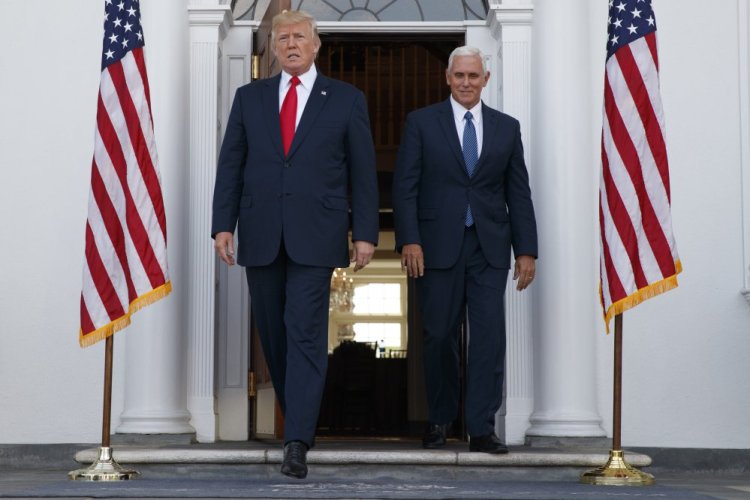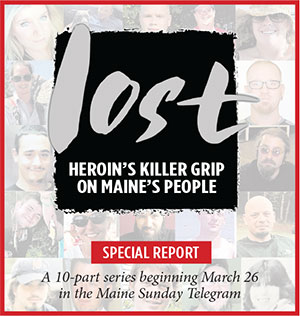WASHINGTON — President Trump declared the country’s opioid crisis a national emergency Thursday, saying the epidemic exceeds anything he has seen with other drugs in his lifetime.
The statement by the president came in response to a question as he spoke to reporters outside a national security briefing at his golf club in Bedminster, New Jersey, where he is on a working vacation.
“The opioid crisis is an emergency, and I’m saying officially right now it is an emergency. It’s a national emergency. We’re going to spend a lot of time, a lot of effort and a lot of money on the opioid crisis,” he said.
Last week, the President’s Commission on Combating Drug Addiction and the Opioid Crisis, led by New Jersey Gov. Chris Christie, issued a preliminary report that described the overdose death toll as “September 11th every three weeks” and urged the president to declare a national emergency.
On Tuesday, Trump received an extended briefing on the subject in Bedminster. White House aides said Trump was still reviewing the report and was not yet ready to announce which of its recommendations he would embrace.
A White House statement issued Thursday evening said that Trump “has instructed his administration to use all appropriate emergency and other authorities to respond to the crisis caused by the opioid epidemic.”
MAINE OFFICIALS REACT
In Maine, where one person per day dies on average from a drug overdose, Attorney General Janet Mills was encouraged by the president’s commitment, but uncertain about how much federal assistance would be available or needed to fight Maine’s epidemic.
“It could easily cost tens of millions of dollars, probably more than $100 million when you think about it,” Mills said, adding that people need to change their attitudes around the stigma of drug addiction. “It’s more than a money issue, it’s a cultural issue.”
Members of Maine’s congressional delegation also welcomed Trump’s declaration.
“Sen. (Susan) Collins has been encouraged by the administration’s resolve to address the crisis and welcomes today’s decision to declare this epidemic what it is – a national emergency,” said Annie Clark, spokeswoman for the Republican senator.
Sen. Angus King, an independent, applauded the step, but cautioned that words alone are insufficient to solve the problem.
“A national emergency declaration could make both a psychological and practical difference. Must back with good policy,” King tweeted.
A spokesman for Rep. Bruce Poliquin, R-2nd District, said the problem requires a multifaceted approach.
“Funding is critically important, but the problem won’t be solved by funding alone,” Brendan Conley said. “Law enforcement and border security are important to combat the poison as it comes into our nation.”
IMPACT UNCERTAIN
The scale of the crisis, which has been building for well over a decade, is such that a presidential declaration may not have much immediate impact. It should allow the administration to remove some bureaucratic barriers and waive some federal rules governing how states and localities respond to the drug epidemic. One such rule restricts where Medicaid recipients can receive addiction treatment.
“There’s no doubt that this shines a brighter light on the epidemic. It remains to be seen how much this will fundamentally change its course,” said Caleb Alexander, co-director of the Johns Hopkins Center for Drug Safety and Effectiveness. “No one thinks the recovery from this is going to be fast, emergency or not.”
The emergency declaration may allow the government to deploy the equivalent of its medical cavalry, the U.S. Public Health Service, a uniformed service of physicians and other staffers that can target places with little medical care or drug treatment, said Andrew Kolodny, co-director of opioid policy research at the Heller School for Social Policy and Management at Brandeis University. He said the Drug Enforcement Administration might be able to use the emergency to require prescriber education for doctors and others who dispense opioids.
“There’s a lot that could be done. It could be very helpful, much more than just symbolic,” he said.
GOVERNORS DECLARE EMERGENCIES
Governors in Arizona, Florida, Maryland and Virginia already have declared emergencies. And in recent months, the Centers for Disease Control and Prevention, the Food and Drug Administration, Congress, physician groups and the insurance industry have taken institutional steps to address the crisis. At the street level, police, firefighters and paramedics now routinely carry naloxone, known by the brand name Narcan, the drug that can bring an overdose victim back from the brink of death.
Drug addiction is a widespread and growing problem, with an estimated 2.6 million opioid addicts in the United States.
The report issued last week says: “The opioid epidemic we are facing is unparalleled. The average American would likely be shocked to know that drug overdoses now kill more people than gun homicides and car crashes combined.”
The report likely understates the severity of the epidemic. The commission based its estimate of the number of fatal drug overdoses on 2015 statistics, when 52,404 people died of overdoses of all drugs, including opioids, for an average of 142 a day. New federal data covering the first nine months of 2016 showed that the death toll had jumped significantly since 2015 and could reach 60,000 once all the numbers are in for that year.
In Thursday’s briefing, Trump said, “It is a serious problem, the likes of which we’ve never had. You know, when I was growing up, they had the LSD, and they had certain generations of drugs. There’s never been anything like what’s happened to this country over the last four or five years.”
HEROIN LACED WITH FENTANYL
Opioids are a broad category of legal and illegal drugs, ranging from prescription painkillers to heroin. In the past couple of years, according to the DEA, much of the street-level heroin in the United States has been laced with illicit fentanyl, a powerful synthetic opioid that is much cheaper to produce than heroin.
Addicts often say they want the most powerful drug they can find and often seek batches of drugs that have been linked to rashes of overdoses.
Although heroin has been around for a long time, the current opioid crisis has its origin in the 1990s, when the pharmaceutical industry marketed new formulations of prescription opioids. Soon they flooded the market, making the United States by far the world’s leading consumer of such painkillers.
At the beginning of this decade, government officials shut down many “pill mills” in which doctors dispensed huge numbers of prescription opioids, and many addicts switched to street heroin.
An analysis published in June by The Washington Post showed that death rates for Americans ages 25 to 44 have risen since the beginning of the decade, a trend seen across almost all racial and ethnic groups and significantly driven by the opioid epidemic. Once stereotyped as a problem in largely white, rural and economically depressed Rust Belt communities, the opioid epidemic has been killing large numbers of people of all races in big cities in recent years – many of them unwittingly having bought packets of powder in which heroin or cocaine has been mixed with fentanyl.
Alexander, of Johns Hopkins, said that while the president’s declaration of an emergency could be used to free up money for treatment and other services, he is concerned that extra funds also might be used for law enforcement, to “clamp down harder” on people with opioid-use disorders.
“We’re not going to arrest our way out of this epidemic,” Alexander said.
Staff Writer Dennis Hoey contributed to this report.
Send questions/comments to the editors.




Success. Please wait for the page to reload. If the page does not reload within 5 seconds, please refresh the page.
Enter your email and password to access comments.
Hi, to comment on stories you must . This profile is in addition to your subscription and website login.
Already have a commenting profile? .
Invalid username/password.
Please check your email to confirm and complete your registration.
Only subscribers are eligible to post comments. Please subscribe or login first for digital access. Here’s why.
Use the form below to reset your password. When you've submitted your account email, we will send an email with a reset code.